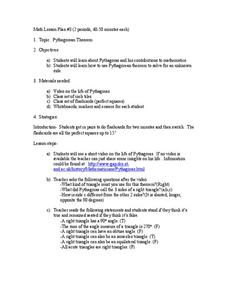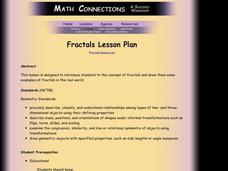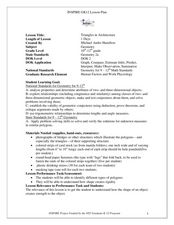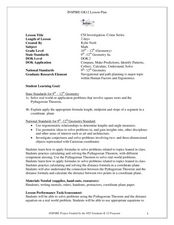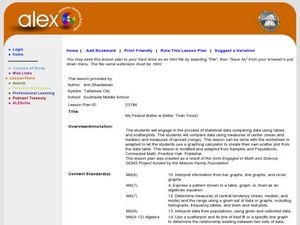Curated OER
Pythagorean Theorem
Students explore the history of Pythagoras and his contributions to mathematics. In this middle school geometry lesson, students use one inch tiles to investigate the Pythagorean Theorem and to find the length of the sides of a right...
Curated OER
Designing a Quilt Pattern
Students create and color a one-patch quilt design based upon a regular hexagon. They examine quilts and photos of quilt designs, read a handout, and complete their quilt design on a worksheet.
Curated OER
Science: Vectors
Students solve vector problems and identify the x and y coordinates. They determine if the coordinates are positive, negative, or zero. Students solve problems and convert the x and y coordinates to magnitude and direction.
Curated OER
Perimeter
Young scholars examine the concept of perimeter. Students calculate the perimeter of a random shape on a grid. Young scholars develop a better understanding of the concept of perimeter. Students calculate the perimeter of shapes.
Curated OER
An Introduction to Quadrilaterals
Students explore different types of quadrilaterals. Students define the terminology used with quadrilaterals. They create particular quadrilaterals based on specific characteristics of the quadrilaterals using an online tool.
Curated OER
Tessellation
Young scholars create an art piece incorporating tessellating shapes, translational symmetry, reflectional symmetry,and or rotational symmetry. They are asked if they know the definition of tessellation. If so, students are asked what...
Curated OER
Fractals
Pupils explore the concept of fractals. In this fractal lesson plan, students use applets to explore Koch's Snowflake, Sierpinski's Triangle, and other fractals. Pupils develop these concepts through exploration and teacher guided...
Curated OER
Similarity and Congruence
Students explore the concept of similarity and congruence. In this similarity and congruence lesson plan, students identify and verify whether or not two figures are similar, congruent, or neither. Students use postulates and theorems...
Curated OER
Similarity and Congruence
High schoolers explore the concept of similarity and congruence. In this similarity and congruence lesson, students cut out strips of paper and form a triangle. High schoolers try to prove that their triangles are congruent using the SSS...
Curated OER
Geometry In the Yard
Pupils are responsible for creating a border around a triangular garden spot, of which they know the measurements for two sides. They use the Pythagorean Theorem to calculate the third side and complete the garden.
Curated OER
Compass Designs
Young scholars investigate the properties of two and three dimensional objects. In this geometry lesson, students differentiate polygons based on similarity and congruence. They make observation and interpret the data.
Curated OER
Make a Box
Students use specific dimensions to create a box. In this geometry lesson plan, students analyze the different properties of two and three dimensional shapes. They make conjectures and use it to solve problems.
Curated OER
Triangles in Architecture
Learners find triangles in the real world. In this geometry lesson, students analyze and identify properties of two and three-dimensional objects. They differentiate between similarity and congruence.
Curated OER
Identifying Lines of Symmetry
Students calculate the lines of symmetry using polygons. In this geometry instructional activity, students graph, compare and estimate using collected data. They identify different attributes to the polygons based on their sides.
Curated OER
Saving Money Through Mathematics
Third graders discuss light sources and collect data about energy sources. They compare data and create a multiple line graph showing energy used by light sources for each student in the group. They present their graphs and write a...
Curated OER
CSI Investigation
Young scholars solve real life situation using the Pythagorean Theorem. In this geometry lesson, students calculate the length, midpoint and slope of segments. They solve word problems using properties of square roots.
Curated OER
Introduction to Fractals: Infinity, Self-Similarity and Recursion
Young scholars think about several of the concepts from fractals, including recursion and self similarity. They use mathematical concepts of line segments, perimeter, area and infinity are used, and skill at pattern recognition is...
Curated OER
Tropical Atlantic Aerosols
Young scholars analyze NASA data from the Multi-angle Imaging Spectroradiometer. In this NASA data lesson, students access an assigned website to examine information from the MISR on the Terra Satellite. They determine how desert dust...
Curated OER
Red October
Fourth graders follow directions given in bearings. They invent their own maps using them and use a protractor to help them with their designs. Students
produce their own maps with instructions for navigating the maps. The channels...
Curated OER
My Peanut Butter is Better Than Yours!
Students explore the concept of statistical data. In this statistical data lesson, students read an article about the dangers of peanut butter to those who are allergic. Students perform a taste test of two different brands of peanut...
Curated OER
Introducing Trig
Fifth graders explore the importance of triangles in the real world. They find the unknown side of a right triangle using a scale drawing. Students use Pythagoras' Theorem and other appropriate ratios.
Curated OER
Altitude Locator
Pupils use protractors, strings, and straws to construct a device used to determine the height of tall objects. In this applied geometry lesson, students use common objects to construct a tangent height guide. They use principles of...
Curated OER
Solving Problems - Writing Equations
In this solving problems worksheet, students read short word statements, translate them into an algebraic equation, and solve the problem. Twelve problems are listed on this one-page worksheet.
Curated OER
Equilateral Triangles
Students examine the attribute of equilateral triangles. In this equilateral triangle lesson, students examine a number of paper triangles to determine how they are classified. They determine how triangles are depicted in Navajo rugs.


